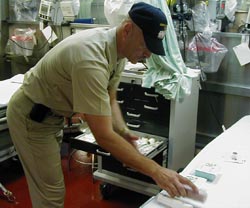
|
Politics
|
Comfort Mission Could Change from Hospital to Hostel
Capital News Service Tuesday, Sept. 6, 2005 WASHINGTON - As the fourth anniversary of Sept. 11, 2001, approaches, the Navy hospital ship deployed to Ground Zero faces a similar disaster environment as it heads to the hurricane-ravaged Gulf Coast. And in a move reminiscent of four years ago, the Baltimore-based USNS Comfort could become a respite for first responders and other emergency crew working in the wake of Hurricane Katrina, in addition to treating survivors. Adm. Timothy J. Keating, commander of the U.S. Northern Command, said in a briefing Monday that the Comfort is flexible enough to accommodate a variety of the region's needs even if New Orleans is almost completely evacuated. If the ship arrives as planned on Thursday, it will have been more than 10 days since Katrina struck. "We may not need so much medical support at that time, but Comfort also provides comfort for workers or troops or sailors . . . who might need a place to live or rest or recuperate," Keating said, according to a transcript of the briefing. "There are not a whole lot of Ramadas still down there where they can take a two- or three-day vacation," he added. The Military Sealift Command, which operates the Comfort, wanted to make clear that Keating's comments were not a declaration of the vessel's mission. The specific details of where the Comfort will dock, and what it will do from there, is not yet definite. "The mission is still evolving, we're still changing," said Trish Larson, an MSC spokeswoman. Ellen Maurer, deputy public affairs officer at the National Naval Medical Center, where most of the Comfort's medical personnel are based, was a sailor on the Comfort when it served as a rest station for emergency workers at the World Trade Center after the 2001 terrorist attack in New York City. She said that providing a place for workers to get a cup of coffee or grab a quick nap is just as important as patient care. She also said that resting aboard the Comfort allowed some emergency workers to avoid feeling guilty about leaving the disaster scene since they were going to a military installation rather than home. "It psychologically gave them permission to take care of their own needs, which is the only way they could continue their mission," Maurer said. Maurer added that if the Comfort shifts to the same kind of relief mission that she served, crew members are willing do whatever is needed. "If it's a doctor performing surgery or who is instead helping out with laundry, they all do it. There are no egos involved in an emergency; it's about taking care of people displaced in this natural disaster."
Banner graphic by April Chan, incorporating photo from the National Oceanic and Atmospheric Administration; Newsline Web content edited by Chris Harvey; Capital News Service stories edited by Adrianne Flynn and Tony Barbieri. Copyright © 2005 University of Maryland Philip Merrill College of Journalism
|

